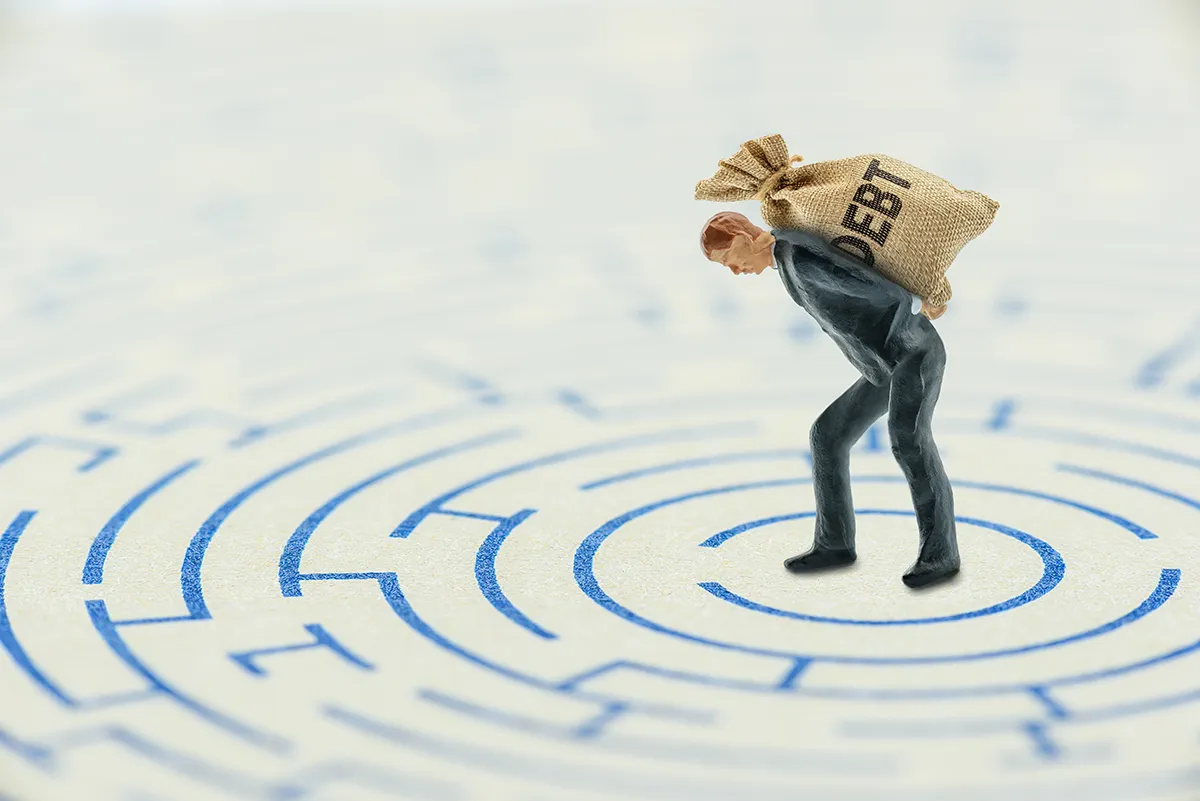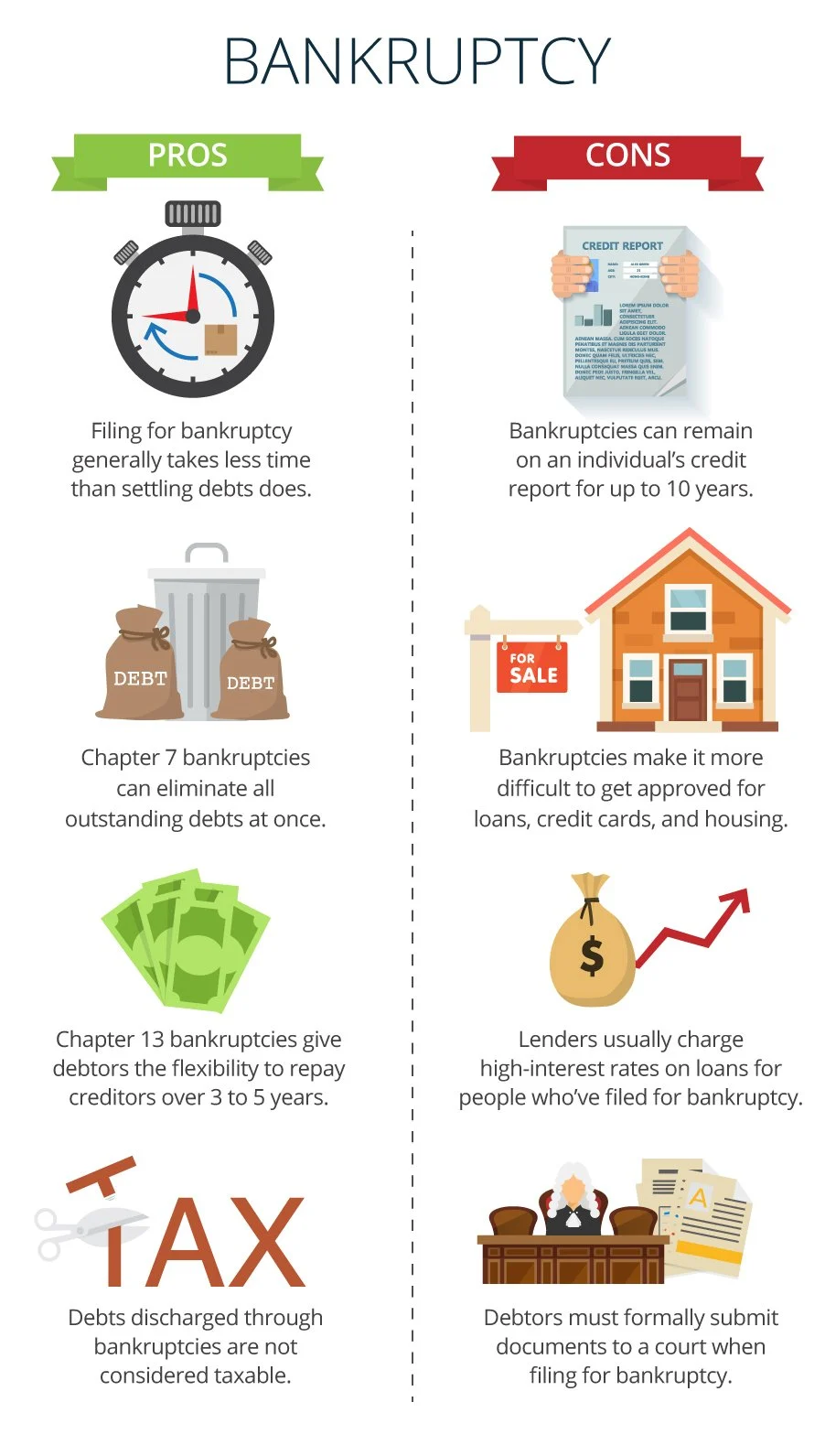Bankruptcy
Bankruptcy is a legal procedure that allows individuals, businesses, and other organizations to discharge debts when they can no longer afford to pay them. The primary objective of bankruptcy is to provide those deep in debt with a fresh start, with the secondary function of paying off creditors as much as possible without severely burdening the debtor any further.
We are not attorneys, so if you are considering bankruptcy or need legal advice, please contact an attorney in your state.
Table Of Contents
- What is Bankruptcy?
- How Does It Work?
- Top Videos Related to Credit Card
- Before Filing for Bankruptcy
- The Three Primary Forms of Bankruptcy
- The Mechanics of Filing Bankruptcy
- Do I Need an Attorney to File Bankruptcy?
- What Happens once I’ve Filed for Bankruptcy?
- Chapter 7 Discharge
- Chapter 13 Discharge
- What are the Consequences of Declaring Bankruptcy?
- Education Center
What is a bankruptcy court proceeding?
In a bankruptcy court proceeding, after examining the assets and liabilities of individuals and businesses who are functionally insolvent, a judge and court trustee determine whether to discharge debts. If the judge and trustee decide to discharge debts, the individual or business who filed for bankruptcy becomes relieved of the requirement to pay them off.

How Does It Work?
Experienced Professionals
Our team comprises seasoned experts who have successfully navigated countless clients towards a debt-free life.
Customized Solutions
We understand that every financial situation is unique. That’s why we craft bespoke debt relief plans tailored to your specific needs.
High Success Rate
Our track record speaks for itself. Our effective strategies and dedicated approach ensure tangible results.
Confidential Consultation
Your privacy is paramount. Rest assured, our consultations are carried out with the utmost discretion and confidentiality.
Credit Card Debt Relief Reviews
Before Filing for Bankruptcy
Prior to a debtor filing for bankruptcy, the individual should make a comprehensive list of all debts, assets, income and expenses. This helps the individual and anyone else involved in a potential bankruptcy filing (including the eventual court petitioner) to gain a clear understanding of the financial landscape involved.
Additionally, within 180 days prior to any filing, bankruptcy courts require petitioners to undergo credit counseling from a Federally approved counseling agency. This typically takes fewer than two hours over the telephone or online, and is done to ensure that all possible alternatives to bankruptcy (such as debt consolidation and debt settlement) have been sufficiently explored. Upon completion of the counseling session, a certificate is issued that must be included within a bankruptcy filing.

The Three Primary Forms of Bankruptcy
Chapter 7 bankruptcy is filed by individual debtors with relatively low income levels.
This bankruptcy proceeding generally involves the paying off unsecured creditors through a liquidation of the debtor’s assets that are non-exempt from liquidation by either state or federal law.
Assets that are generally considered exempt include your home, a car utilized for work, retirement savings, welfare entitlements and Social Security checks. These types of assets are protected from liquidation to repay debt.
However, non-exempt assets include cash, funds held in bank accounts, funds held in the stock market, jewelry, collectibles, and any second homes or cars. These types of non-exempt assets will be subject to liquidation under a Chapter 7 proceeding, with the resultant funds raised utilized to pay off creditors.
Chapter 13 Bankruptcy is filed by individual debtors who possess an income higher than the median level of the state in which they reside and is an option for people whose income may be too high to file for Chapter 7 relief.
This type of bankruptcy proceeding involves designing a three- to five-year repayment plan that necessitates paying off some creditors in order to have other debts forgiven. When the repayment plan is completed, remaining debts are discharged.
Chapter 11 Bankruptcy is most often utilized by businesses, though some individuals use it when their debts exceed the limits granted in Chapter 13. A Chapter 11 is considered a “reorganization” bankruptcy proceeding, as it provides businesses the opportunity to continue operating while restructuring debts.
Businesses ranging in size and scope from large multinational corporations to relatively small partnerships utilize Chapter 11 to pay off debts over time without having to sell assets or cease operations.
The Mechanics of Filing Bankruptcy
Regardless of the type of bankruptcy, following the mandatory credit counseling session, the debtor files a bankruptcy petition with a federal bankruptcy court in the debtor’s district. This initiates an automatic stay that inhibits creditors and collection agencies from continuing to contact or harass the debtor.
In filing a bankruptcy petition, the debtor provides information related to:
- income,
- expenses,
- names of creditors,
- amounts owed,
- and assets.
This information is then turned over to a court appointed trustee – often a bankruptcy attorney, who oversees and manages the entire process while maintaining contact with the petitioner and requesting additional information when necessary.
When filing, the petitioner provides specifics as to his average income over the previous six months. If this income is below the median income for his state, then he can file under Chapter 7 bankruptcy protection.
However, If this income is above the median, then the filer must fill out a form detailing monthly income and expenses to determine whether he has the means to pay off some of the debt within three to five years. If the means test indicates that the debtor can do so, then he files under Chapter 13 bankruptcy protection.
The Mechanics of Filing Bankruptcy
Regardless of the type of bankruptcy, following the mandatory credit counseling session, the debtor files a bankruptcy petition with a federal bankruptcy court in the debtor’s district. This initiates an automatic stay that inhibits creditors and collection agencies from continuing to contact or harass the debtor. In filing a bankruptcy petition, the debtor provides information related to income, expenses, names of creditors, amounts owed, and assets. This information is then turned over to a court appointed trustee – often a bankruptcy attorney, who oversees and manages the entire process while maintaining contact with the petitioner and requesting additional information when necessary.
When filing, the petitioner provides specifics as to his average income over the previous six months. If this income is below the median income for his state, then he can file under Chapter 7 bankruptcy protection. However, If this income is above the median, then the filer must fill out a form detailing monthly income and expenses to determine whether he has the means to pay off some of the debt within three to five years. If the means test indicates that the debtor can do so, then he files under Chapter 13 bankruptcy protection.
Do I Need an Attorney to File Bankruptcy?
Though consulting an attorney is not a requirement for filing bankruptcy, it is generally advisable. A clear understanding of which federal and state laws apply to your situation can lead to the best possible outcome as to which debts eventually are discharged. Judges and employees of the court, including the petitioner, are not permitted to dispense legal advice regarding your filing. There are important differences between filing bankruptcy under Chapter 7 and Chapter 13.
In either case, there will be numerous forms to complete, and if you lack a full understanding of the rules and procedures associated with your particular case, the outcome may not go as well as it otherwise could with an experienced attorney by your side. Search for options for free (pro bono) legal services if you cannot afford to hire an attorney.
What Happens once I’ve Filed for Bankruptcy?
Within three to six months of filing for Chapter 7 bankruptcy protection, the individual must attend a creditor’s meeting that generally takes place in the debtor’s county. This meeting provides creditors the opportunity to ask questions of the debtor in person, though credit card companies and large banks rarely take the opportunity to show up.
The trustee asks questions related to the forms filed by the petitioner in an interview that is generally only a matter of minutes. Though any creditors in attendance are entitled to ask questions, they can do little to stop the likely inevitable discharge of debts that results within a few months of the creditor’s meeting.
Chapter 7 Discharge
Prior to being granted discharge under Chapter 7, the debtor will undergo a brief budget counseling session through a Federally approved credit counseling agency.
Once completed, the discharge erases credit card debts, loans, medical expenses, legal expenses and court judgments. However, obligations including but not limited to Federal student loans, taxes, alimony and child support, debts that arose following the bankruptcy filing and debts resulting from driving under the influence of alcohol are not eliminated through bankruptcy.
Additionally, bankruptcy may not relieve any co-signers from financial responsibility on all or part of any loans that they agreed to pay off if the debtor could not.
Chapter 13 Discharge
After formulating a three- to five-year repayment plan, the debtor must attend a creditor’s meeting in which any creditors present will have the opportunity to voice their objection to the plan. Any issues that arise out of this meeting can be raised at an ensuing confirmation hearing, where the debtor will present the repayment plan before the judge.
If the plan is approved, the debtor makes payments to the trustee, who then allocates funds to creditors according to terms laid out in the repayment plan. If the plan is not approved, the debtor can amend the plan and present it in front of the judge again at another confirmation hearing. Once approved, the debtor becomes eligible for debts to be discharged, but only after the repayment plan is fulfilled.

What are the Consequences of Declaring Bankruptcy?
The chief reason that an individual declares bankruptcy is that it provides the benefit of a fresh start and a second chance at financial well-being.
Whether it was caused by a series of poor financial decisions, improper long-term planning, bad luck, or some combination thereof, an insurmountable debt balance can render bankruptcy as the best viable alternative available.
The emotional relief that results from removing the stress of monstrous debt is often worth the consequences of filing for bankruptcy. However, bankruptcy should not be entered lightly without an understanding of the long-term consequences. For example, a Chapter 7 bankruptcy will remain on a credit report for ten years from the filing date, and a Chapter 13 bankruptcy will remain on a credit report for seven years from the filing date.
Either can impede your ability to obtain new lines of credit and potential employers may frown upon this aspect of your financial history.
It is likely that a bankruptcy discharge will lower your FICO credit score toward the low 500s. However, if you’re already considering filing for bankruptcy, it’s likely that your credit score isn’t as strong as it once was anyway.
Moreover, with careful planning and responsible financial behavior, particularly in the first two years following a bankruptcy discharge, it is possible to rebuild a FICO credit score to healthy levels following bankruptcy.
Nonetheless, before deciding whether to file bankruptcy and incurring the long-term stain of a bankruptcy discharge on your credit report, be certain to investigate other alternatives such as debt consolidation and debt settlement.
Top Videos Related to Credit Card
Bankruptcy
Explore the intricacies of bankruptcy as a legal process designed to provide relief for individuals, businesses, and other entities overwhelmed by debts. We delve deep into the specifics of Chapter 7, 11, and 13 bankruptcies, each offering unique paths for managing and discharging debts.
Too Much Credit Card Debt
Problems begin to arise when a borrower becomes too cavalier with credit lines and begins to use credit cards for extravagances and other expenditures that stretch the individual to live beyond his or her means.
Credit Card Interest Rates
Interest rates for credit cards fall into three categories: variable, fixed and promotional. Take the next steps to lower your credit card interest rates.
Education Center

Credit Cards And Your Credit
Bankruptcy FAQ
Master Your Finances:
Our Latest Insights & Articles

